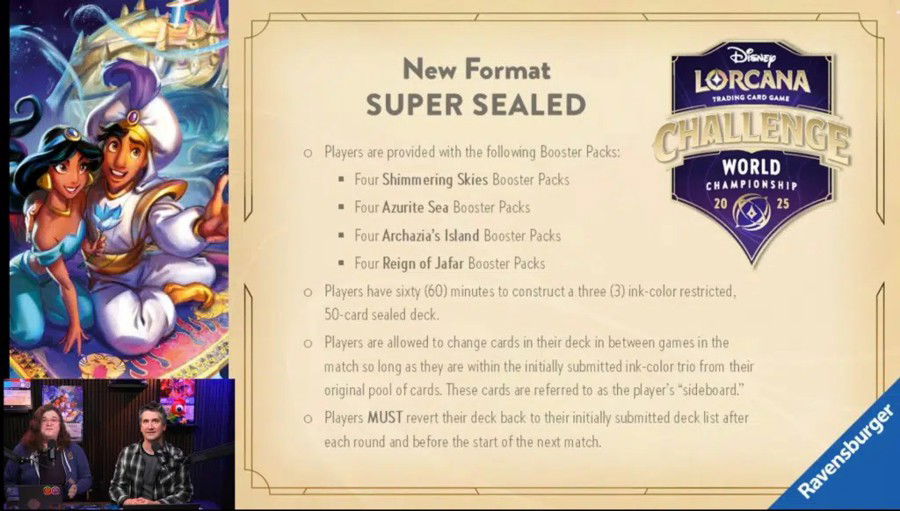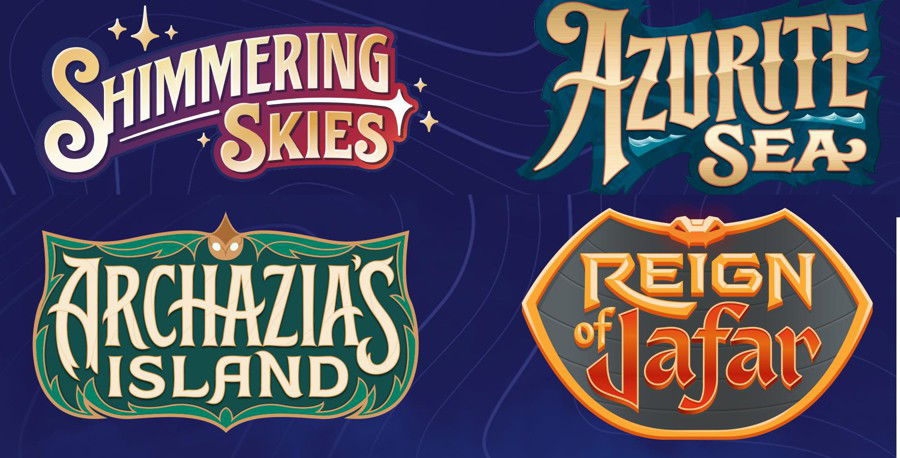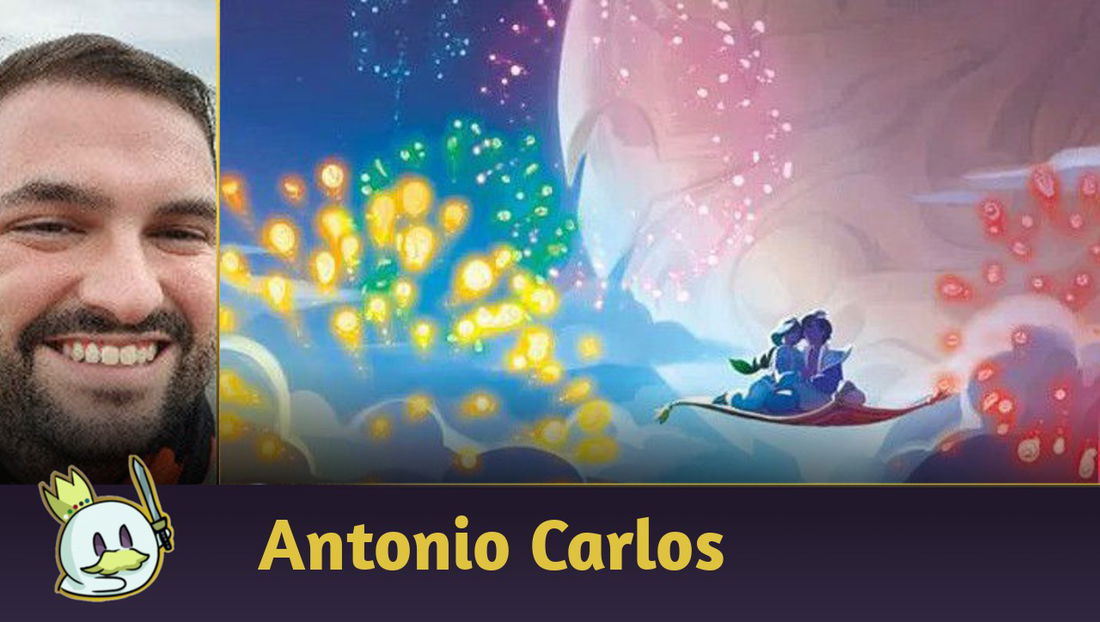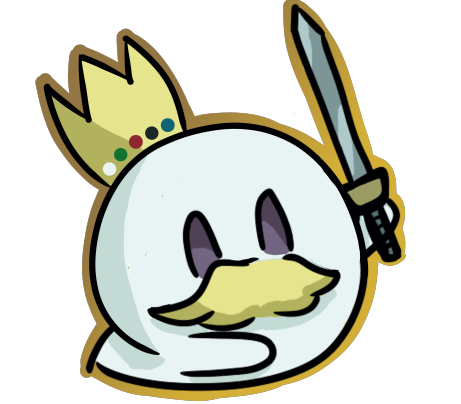The First Lorcana World Championship!
Hello, everyone!
On the weekend of June 28-29, the first ever Lorcana World Championship will be hosted in the United States, right at Walt Disney World! The event will bring together the top finishers in the Disney Lorcana Challenges and Continentals, so a high level of play is expected.
It will be an exclusive event, so much so that it was decided not to open it to the public. However, the entire event will be broadcast via the official Lorcana Channel on Twitch!
For this very special event, we'll have mixed Formats: first, participants will play in a Limited format - that is, they will receive an amount of sealed booster packs and build a deck with whatever they open -, and then in a Constructed format - that is, with decks already prepared and defined.
In today's article, we will review and analyze the Limited part of the event! Let's go!
Super Sealed - Rules

As we can see in the image above, taken from the official Disney Lorcana broadcast by Ravensburger on Twitch, the Super Sealed aims to evaluate the adaptability and flexibility of the players.
- Each one will open sixteen booster packs, four from each of sets 5, 6, 7, and 8. They will have one hour to decide:
- Which three colors will be used from their entire pool of cards;
- Among these three colors, which 50 cards they'll use as their main deck, that is, the configuration that must be used in the first game of each match - the remaining unused cards in those colors will be the sideboard.
The dynamics of the Super Sealed, with such a large amount of boosters available, helps to minimize the luck factor. We have to consider that each participant will have at their disposal one hundred and ninety-two cards - sixteen boosters with twelve cards each -, and the distribution of rarities will be as follows:
- 96 common;
- 48 uncommons;
- 32 rares or super rares or legendary;
- 16 foils, of any rarity.
In other words, without taking into account the randomness of the foils, we know that 144 of the 192 available cards will be common or uncommon. Considering, also, the three-ink restriction inks in the deck, opening an absurdly strong card does not automatically mean that the player will use it, since it depends on the rest of that ink providing the necessary support.
Although, of course, there are rare+ cards that can define games by themselves - in Limited, usually referred to as bombs -, it will be a one-of card among fifty, so it is not exactly consistent. Most decks will need to focus on commons and uncommons to build a strategy.
With this in mind, let's analyze the themes that appear in these four sets that will be part of the Super Sealed, and also identify the best common cards in each ink!
Reviewing the Sets

Themes
It is important to identify some common points and synergies between the sets, so that you can quickly look for key cards in the pool that'll guide you to certain ink combinations.
Locations
Examples:

Locations are a theme focused on the 5th and 6th sets. Only these two sets have cards of this type, with six uncommons in the 5th set and six commons in the 6th set.
Although not many, the cards that take advantage of Locations are quite interesting, with emphasis on the common Fix-it-Felix, Jr. - Delighted Sightseer, which draws a card immediately when played if you control a Location.
Knights
Examples:

Knight type characters, especially those themed after the alternate version of Snow White and the Seven Dwarfs and those from The Sword in the Stone, are concentrated in Steel ink, but are touched upon slightly in other colors. The bonus effects help a lot in Challenges, so we highlight the common Sneezy - Noisy Knight, a good on-curve character that helps you make a positive trade.
Pirates
Examples:

This is one of the themes with a lot of available cards between sets, and therefore should appear more often in the super sealed decks. It also appears in practically all ink colors, and among several rarities.
Pirates have many abilities to disrupt the opponent's game, while also sticking characters on the board. A highlight is John Silver - Ship's Cook, a good turn 3 character who indirectly protects your entire board from a threat!Inventors
Examples:

Inventors are concentrated in Emerald and Sapphire, and their effects can be related to items, or to ramping up your inkwell. It's important to associate these two colors with, possibly, the third color that has the most items in your pool, if you opt for this archetype.
The highlight is the common Aunt Cass - Biggest Fan, even though it is not an Inventor type, because she grants a nice Lore buff to a character that has the type.
Illusions
Examples:

Lastly, Illusion cards appear in the 7th and 8th sets, concentrated in the Amethyst and Steel colors. They are particularly efficient characters in Limited, since they have above-average stats and there aren't many tools available, on average, for the opponent to take advantage of the Vanish mechanic.
The highlight is the common Treasure Guardian - Foreboding Sentry, again a character who is not an Illusion-type, but draws a card when played as long as you control an illusion. It also has reasonable stats, and even Quests for two Lore!
Best Common Cards
Now, let's identify the best commons in each set, which probably means we'll see them a lot throughout the Worlds' Broadcast!
Shimmering Skies

Felix and Heihei combine good defensive stats with the Bodyguard ability, protecting your board and probably forcing your opponent to make unavoidable trades.
Archimedes and Zazu are characters that combine good Lore generation, each with two on-Quest, and the powerful Evasive ability, making it difficult for your opponent to interact through challenges.
Donald is an interesting cost-benefit ratio, since it guarantees more ink on your next turn without spending a card from your hand, and still has strong stats.
Finally, Simba is a 1-Drop that remains relevant even in a longer game, since it allows positive trades later on, all for a small investment - and on top of that, leaves you with a character on the board.
Azurite Sea

Chip helps develop your board while increasing your Lore, remaining relevant even in a longer game. John Silver, in the same vein, prevents an opponent from taking advantage of characters that need to challenge in order to activate some effect.
Tinker Bell is another threat that combines good Lore generation with evasion.
Prepare to Board and Sail the Azurite Sea are very useful actions, creating advantageous situations and helping with consistency.
Abu combines two excellent qualities: it's a removal for characters with 4 or less Willpower, and afterward it's an excellent Lore generator. For a common, it seems well above the curve!
Archazia’s Island

King Stefan, Rajah, and Berlioz are above-average stats characters for their respective ink costs, which means they can make positive trades in a game - it wouldn't be surprising if each of them could deal with at least two of the opponent's characters, for example.
Robin Hood and Jafar have a more supportive role, geared towards positive trades - they help your smaller characters easily deal with the opponent's larger threats.
Finally, Out of Order is one of the few spot removals among all the available sets, and it stands out precisely because it is Common. Although it has a high cost, it is one of the few ways to deal with an opponent's bomb without wasting a lot of resources.
Reign of Jafar

Once again, we continue valuing positive trades, this time with Calhoun, Yelana, March Hare and Hook. Hook is perhaps one of the best 1-Drops in the game, and since it is common it would be wrong not to highlight it - it can even trade with 4-cost characters! Calhoun brings a nice effect to Amber ink at common rarity, while Yelana and March Hare combine the potential of a positive trade and a character with good Lore generation.
The Wardrobe is a common card with the text: draw two cards. The condition, in this case, is to discard an item, which is quite reasonable, especially considering it is from the Sapphire ink. Card advantage is a clear path to victory in any Limited environment.
Finally, Mushu is an excellent card to enable several characters with Challenge effects, without having to wait for their ink to dry. It helps both in positive trades and to allow you an edge in any challenge.
Conclusion
Although some comments about luck initially arose in response to the announcement of this format for Worlds, the truth is that Limited, in general, tends to be a greater measure of skill in card games than Constructed. In Limited formats, some basic understandings of the game are put to the test, such as recognizing synergies and strong cards, identifying a game plan and executing it, knowing how to play around potential threats from opponents, knowing when to trade and when to Quest, among others.
It is undoubtedly an excellent choice to have a Limited format as part of the event, and even better if it is highlighting the sets that remain in Core Constructed after the rotation! We will have the opportunity to see different ideas and some forgotten cards in action.
What did you think of this format choice for Worlds? Share with us in the comments!
In the next article, we will analyze the Constructed format of Worlds, the Triple Deck Constructed!
Hugs, and see you next time!












— Comentarios 0
, Reacciones 1
Se el primero en comentar